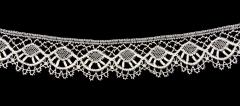ENGLAND: THE OTHER WITHIN
Analysing the English Collections at the Pitt Rivers Museum
Lace Techniques
Nicolette Makovicky,
Junior Research Fellow, Wolfson College
Tatting
Developed as an imitation of point lace, tatting is a form of lace made with a shuttle containing wound thread. The lace is made by constructing a chain of loops and knots over a core thread: When using a shuttle, a lace maker winds a length of thread around one hand and keeps the shuttle in the other hand, forming a central loop. The shuttle is then passed through this loop from above or below to form knots. Called frivolité in French – a reference to the supposed frivolous nature of its use and possibly even the nature of the activity - tatting emerged in the late 19th century and was used to make doilies, collars, cuffs and other accessories.
Bobbin Lace
Bobbin lace is made by weaving or plaiting threads into a mesh. The thread – linen or cotton for crocheting – is wound onto bobbins at each end to form a pair. Once the required number of pairs has been wound, depending on the width of the lace the maker wishes to create, they are hung from pins stuck into a large flat or sausage-shaped pillow through a cardboard, pre-punched template. The majority of the pairs hang vertically and these regulate the width and the density of the lace. One or more pairs are added, at designated points, to those already hung on the pins and these are the travelling or working pairs. These pairs are intertwined with the vertical pairs in order to form the decorative elements. In Britain, bobbin lace was made in Buckinghamshire, Bedfordshire and Devon (Honiton) and employed thousands of men and women until the mid-19th century.
Needle Lace
Needle lace is made with needle and thread of various thicknesses. When starting a pattern, the lace maker makes the first stitches on a firm background, such as a piece of thick paper, and then fills in the remaining area with hundreds of tiny stitches made ‘in the air’ (not through the paper). Often, the motif will be printed or drawn on the underlying cardboard. There are several different types of stitches used, most being a variety of the buttonhole or blanket stitch. Venice and Alençon (France) have famous traditions of needle lace making.
Carrickmacross Lace
Carrickmacross lace originating in Ireland in the 19th century and is a form of needle lace worked on fine machine made netting. A template of muslin textile is attached to a length of netting and then the outline of the design is stitched through both with a thicker thread (‘padding thread’). The unwanted muslin between the motifs is then cut away and the space in between filled with a buttonhole stitch.
